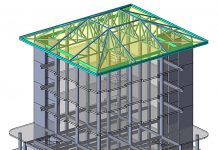Karen Alford, BIM Project Executive at the Environment Agency discusses how industry can adapt to the BIM revolution by utilising the standards and data currently available
I recently read one of Charles Darwin’s quotations from 1809; “It is not the strongest of the species that survives, nor the most intelligent but the one most responsive to change”. Is it going to be the most adaptable organisations that survive the BIM revolution as it’s introduced to government led construction projects in the UK?
Unlike most other industries construction has not changed significantly for many years and up until this point has escaped the need to react to changes in customer demands which can throw their whole business model into a state of disarray. The landscape of the retail industry has changed dramatically this century with the rise of internet shopping combined with more demanding customers with a world market at their fingertips. Many long-standing faces on the high street have disappeared, others have modified their operations to enable them to compete, and new ones have emerged to be global leaders.
I recently attended a ThinkBIM session in Leeds and learnt about how Hobson & Porter responded to an East Riding of Yorkshire Council BIM model driven tender for a new fire station for the Humberside Fire Rescue Service at Clough Road in Hull. The SME was daunted at first but embraced the challenge and recognised the opportunity for them to understand what it meant for their business, their supply chain and most importantly, delivering a project in a different way for the benefit of their client.
The Government Construction Strategy 2011 set out some challenging efficiency targets and these were built into the Construction Strategy 2025. Industry leaders agreed to deliver a 33% reduction in whole life cost of built assets, 50% reduction in time from inception to completion and 50% lower emissions by 2025. These ambitious targets will not be achieved by simply adding a piece of software or two to existing practices, but I am fearful that some within the industry still believe this alone is going to deliver Level 2 BIM and modernise the industry.
The retail industry uses technology and data analytics in many ways to better understand their customer needs. Tracking customer movements within a store to improve layout is common place and we have all noticed how seasonal stock appears when certain weather conditions prevail. As a customer we can track the location of our parcel at any time of day wherever it may be in the world. Although the application and deliverables will be different, as a construction industry client, we expect to progressively benefit from the innovative use of data combined with a range of technological solutions to provide a comparable service.
The government continues to forge ahead with its digital agenda to improve and modernise its own operations, make it easier for others to do business with, and save £33bn from the public purse. The Level 2 BIM deliverables are all about making it easier for the construction industry to do business, sharing data and information, and building on what others have created rather than re-inventing what already exists.
The effort involved in exchanging documents and information can be surprisingly large. The Environment Agency exchanges about 10,000 documents within projects via its project workspace every month. It can be difficult to comprehend just how many transactions occur within a business and if these are not managed efficiently it can be a costly affair.
The BS/PAS 1192 suite of standards set out a framework, which if adopted, allows the industry to share data and information in a common way, using common naming conventions and exchange methods. Most client and supplier organisations use some form of project workspace, which is likely to be configured slightly differently and with a range of working protocols slightly tailored to each customer. This type of back office activity creates a cost burden to the business. If the PAS 1192 approach is implemented at an organisational level it provides a common workflow and assurance methodology which is good practice whether a customer formally requests it or not.
There is much debate around COBie, which is part of the PAS 1192 suite of standards. However, in its simplest form it provides the functionality of an issues sheet, commonly used within the industry, but with the added benefit of a structured schema to allow the client to manage their data and information more efficiently, and takes us all one step closer to a Digital Built Britain.
The starting place for building information models is to get a handle on how data and information is currently used within your business and the processes deployed to support it. The full benefit of technology can only be realised when it is treated as part of a wider business change programme, and existing roles and activities are reviewed and adapted to seek out the new opportunities operating in a digital environment and what this can bring to a business and industry.
Government driven BIM is providing the pull but is the industry gearing itself up to give the push?
Karen Alford FCCA
BIM Project Executive
Environment Agency
karen.alford@environment-agency.gov.uk













